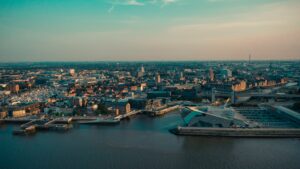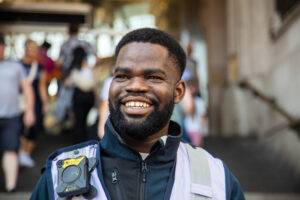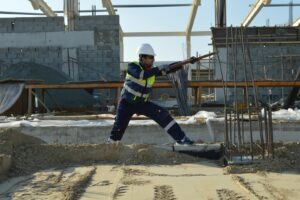 In Cleveland, Ohio more than a third of people live below the poverty line. Lee Chilcote discovers how the upcycling movement is becoming a force for reinvention – benefitting the environment, boosting the local economy and helping people to ‘reclaim their discarded neighborhoods’
In Cleveland, Ohio more than a third of people live below the poverty line. Lee Chilcote discovers how the upcycling movement is becoming a force for reinvention – benefitting the environment, boosting the local economy and helping people to ‘reclaim their discarded neighborhoods’
When David Van Horn’s mom first told him about the Upcycle Parts Shop in the St. Clair Superior neighborhood of Cleveland, they both thought it was a motorcycle shop. That’s the kind of business that’s common in this low-income neighborhood on the city’s east side. Yet when Van Horn learned that it was actually a craft store for salvaged materials, he got excited.
‘I found out they were hiring and it seemed like the perfect job,’ says Van Horn, a 27-year-old who has lived in the neighborhood his whole life. ‘I wanted to do something to get more involved. I heard about upcycling, crafting, and their vision – I wanted to have more connections in the neighborhood, and also to connect people who are in the neighborhood to each other.’
Today, Van Horn is manager of the Upcycle Parts Shop, a 600-square-foot storefront on St. Clair Avenue that he says has become a much-needed ‘safe space’ in a neighborhood dotted with empty storefronts. ‘People see that we care about our neighbors, that someone like me works here and it’s a multi-ethnic company, and that we’re interested in supporting local businesses,’ he says.
The Upcycle Parts Shop is the brainchild of Nicole McGee, an artist-entrepreneur who launched an upcycling business called Plenty Underfoot about five years ago. McGee’s specialty is turning junk into functional artwork – for example, transforming scraps of vinyl flooring into colorful necklaces and making lovely floral centerpieces out of plastic, newspaper and wire. She also teaches upcycling to kids and hosts an annual pop-up shop for creative reuse artists.
‘Reuse is a smart revitalization and engagement strategy and is catching on in Cleveland,’ says McGee, 35, who moved to Cleveland for a job as a community organizer. ‘It’s a kind of third space, a common ground where people connect to each other and their sense of purpose. It also highlights the same paradigm on a neighborhood level. It raises the question, “How do we reuse the neighborhood?”’
Cleveland, which has a 37% poverty rate, has plenty of neighborhoods like this one that are in need of reinvention. Upcycled products can be more than just pretty art for people who can afford it, McGee says – she wants to use it as a strategy to build community among diverse groups, help local residents start businesses, and attract visitors to St. Clair Superior.
Two years ago, McGee partnered with the nonprofit St. Clair Superior Development Corporation to launch the Upcycle St. Clair project. St. Clair Superior Development Corporation was awarded a $375,000 grant from ArtPlace America, a national foundation that gives grants to creative place making projects. Two years later, the project is starting to show results.
Last year, McGee and St. Clair Superior opened the Upcycle Parts Shop inside the wood-floored storefront in the 100-year-old Slovenian National Home building. A far cry from your typical commercial craft store, the store is like an upcycling warehouse packed with a bewildering array of trash-to-treasure. There are bins of swirling beads, drawers of bright fabric and stacks of multi-hued leather, all just waiting to be reborn. The eclectic venue boasts an ‘art bar’ where McGee hosts monthly craft sessions free for neighborhood residents.
McGee is bubbly and full of energy, a prerequisite for the job. She’s constantly getting donation offers, from the teacher giving away her entire art closet to the family donating grandpa’s lifetime of hardware supplies. Hauling waste materials around in her car can get a little awkward at times. ‘We just got a huge amount of leather samples from an upholstery company,’ she says with a laugh. ‘My car smells like a slaughterhouse right now from all that hot leather.’
 In the past year, the Upcycle Parts Shop has diverted six tons of material from area landfills. Yet there’s a richer, deeper purpose at work, too – teaching people about upcycling can help them reclaim their discarded neighborhoods, McGee says, rattling off story after story about connections she’s made in the community, like the women who learned how to make paper-and-plastic bouquets at an open crafting session. They now make their own versions at home.
In the past year, the Upcycle Parts Shop has diverted six tons of material from area landfills. Yet there’s a richer, deeper purpose at work, too – teaching people about upcycling can help them reclaim their discarded neighborhoods, McGee says, rattling off story after story about connections she’s made in the community, like the women who learned how to make paper-and-plastic bouquets at an open crafting session. They now make their own versions at home.
‘People say stuff to us like, “This kind of place never happens in this neighborhood,”’ says McGee, who first got the idea for a creative reuse center after attending a meeting of the National Reuse Alliance. There are now more than 50 centers across the U.S. ‘That’s humbling and inspiring.’
The idea behind Upcycle St. Clair may seem a bit fanciful. After all, the average household income in St. Clair Superior is less than $20,000 per year and the average life expectancy is 16 years lower than in nearby suburban communities. Yet McGee cites Txoko Cleveland (pronounced ‘choko’), a series of neighborhood dinners where residents talk and craft over a meal, as an example of successful community building. This summer, she also used a grant from a local funder to employ six neighborhood youth who painted murals on empty storefronts.
‘I love the kids, and they always come running, but I really love when you can activate the kids in adults,’ she says. ‘It’s there, you just have to bring them out.’
Upcycling is being woven into neighborhood redevelopment efforts in other ways, too, says St. Clair Superior CDC Director Michael Fleming. On a vacant lot at East 64th and St. Clair, SCSDC is breaking ground on a park and community space that will have an unusual surface made of upcycled tyres. Fleming says tires are often dumped in the neighborhood, so this will put them to better use. He plans to hire local residents to re-weave the materials into a permeable surface.
‘We know it can be done,’ says Fleming. ‘The question is, “Can we create a small potential business here out of materials that would otherwise cost a lot to dispose of and be a burden to the city?”’
The CDC is also rehabbing a vacant home on East 67th Street using upcycled materials. It will go up for sale for about $60,000, which is a low price but still aggressive for the neighborhood. Fleming believes it will sell and he’ll be able to use it as a template for future homes.
The group also recently obtained a $735,000 grant from the Kresge Foundation for the AgReCulture project, which aims to create more healthy local food options in the neighborhood and engage long-term residents in revitalization efforts. The Hub 55 project is now transforming a once-dead zone on East 55th Street into a fresh foods market, café and brewery.
In addition to the Upcycle Parts Shop, several other upcycling businesses have moved into the neighborhood. They include Rust Belt Reclamation, which turns salvaged wood and metal into new furniture; Borrow Vintage and Rentals, which rents furniture and vintage décor; and Negative Space Gallery, an art space run by Gadi Zamir, who uses salvaged materials in his artwork.
Fleming is under no illusions that upcycling alone will reinvigorate St. Clair Superior, yet he sees it as one part of an overall strategy. ‘We definitely have a long way to go,’ he says.
McGee believes the group’s approach to upcycling can help create a neighborhood where long-term residents are part of the change, not pushed out by it. ‘Creative place making is not about putting creative people in a place,’ she says. ‘We’re not leaders, we’re facilitators. We engage existing residents in the future of a place.’

















Leave a Reply